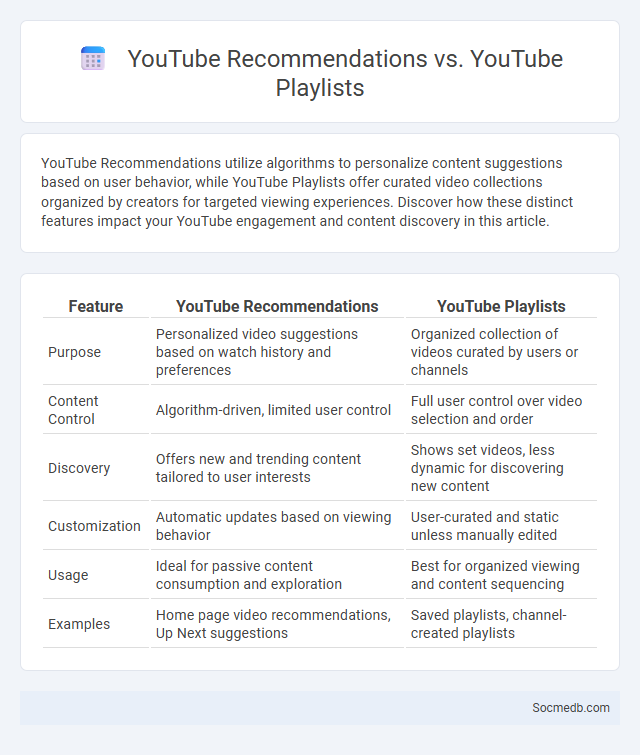
Photo illustration: YouTube Recommendations vs YouTube Playlists
YouTube Recommendations utilize algorithms to personalize content suggestions based on user behavior, while YouTube Playlists offer curated video collections organized by creators for targeted viewing experiences. Discover how these distinct features impact your YouTube engagement and content discovery in this article.
Table of Comparison
| Feature | YouTube Recommendations | YouTube Playlists |
|---|---|---|
| Purpose | Personalized video suggestions based on watch history and preferences | Organized collection of videos curated by users or channels |
| Content Control | Algorithm-driven, limited user control | Full user control over video selection and order |
| Discovery | Offers new and trending content tailored to user interests | Shows set videos, less dynamic for discovering new content |
| Customization | Automatic updates based on viewing behavior | User-curated and static unless manually edited |
| Usage | Ideal for passive content consumption and exploration | Best for organized viewing and content sequencing |
| Examples | Home page video recommendations, Up Next suggestions | Saved playlists, channel-created playlists |
Understanding YouTube’s Recommendation Algorithm
YouTube's recommendation algorithm analyzes your watch history, search queries, and engagement patterns to deliver personalized video suggestions that keep you engaged longer. Machine learning models evaluate video metadata, viewer behavior, and content popularity to rank videos based on relevance and predicted interest. Optimizing your content for factors like watch time, click-through rate, and audience retention can enhance your visibility within YouTube's recommendation system.
What Are YouTube Playlists?
YouTube playlists are curated collections of videos grouped together based on a specific theme or topic, allowing viewers to watch content sequentially without searching for each video individually. These playlists improve user engagement by organizing content for easy access and extended viewing sessions. You can use playlists to categorize your videos, enhance channel navigation, and boost watch time on your YouTube channel.
How YouTube Recommendations Work
YouTube recommendations are powered by a sophisticated algorithm that analyzes user behavior such as watch history, search queries, and engagement metrics like likes, comments, and shares. The system uses machine learning models to predict videos an individual is most likely to watch and recommend content tailored to their preferences. This personalization enhances user retention and increases watch time by continuously adapting to changing viewer interests in real-time.
Comparing YouTube Recommendations and Playlists
YouTube recommendations use an algorithm that analyzes your viewing history, engagement, and preferences to suggest personalized videos, providing a dynamic and continuously updated content feed tailored to your interests. Playlists, curated either by users or creators, offer a structured and thematic approach to video consumption, allowing you to explore specific topics or moods in a sequential manner. Both features enhance your YouTube experience, balancing discovery through algorithmic suggestions with intentional viewing through organized content collections.
Personalization: Recommendations vs Playlists
Personalization in social media enhances your content experience by leveraging algorithms to generate tailored recommendations based on your interactions and preferences. While recommendations adapt dynamically, playlists offer curated, fixed collections often created by users or platforms, providing a more structured content journey. Balancing these approaches improves engagement by combining personalized discovery with organized content selection.
Benefits of Creating YouTube Playlists
Creating YouTube playlists enhances user engagement by organizing content into themed collections, making it easier for viewers to find and watch related videos continuously. Playlists improve channel SEO by increasing watch time and session duration, signaling YouTube's algorithm to promote the content more effectively. Customized playlists also boost brand authority and viewer retention, fostering a loyal audience base and higher subscriber growth.
Limitations of YouTube’s Recommendation System
YouTube's recommendation system often reinforces echo chambers by promoting content similar to what users have previously watched, limiting exposure to diverse perspectives. The algorithm prioritizes engagement metrics like watch time and click-through rates, which can result in the amplification of sensational or misleading videos. Your experience may be constrained by these biases, reducing the potential for discovering balanced and varied content.
Enhancing User Experience: Playlists or Recommendations?
Personalized playlists and algorithm-driven recommendations both significantly enhance user experience on social media by increasing content relevance and engagement. Playlists offer curated, thematic content that caters to specific user preferences and moods, while recommendation systems utilize machine learning to analyze behavior patterns and suggest new content dynamically. Integrating these features optimizes user retention, amplifies discovery, and boosts overall platform interaction metrics.
Algorithmic Bias in YouTube Recommendations
YouTube's recommendation algorithm can perpetuate algorithmic bias by disproportionately promoting content that aligns with users' existing preferences, potentially reinforcing echo chambers and limiting exposure to diverse perspectives. This bias stems from the algorithm's optimization for engagement metrics like watch time and click-through rates, which may prioritize sensational or extreme videos. Addressing YouTube's algorithmic bias requires continuous refinement of recommendation models to balance relevance, diversity, and user well-being.
Choosing the Best Approach for Content Discovery on YouTube
Selecting the best approach for content discovery on YouTube involves prioritizing audience engagement metrics such as watch time, click-through rate, and viewer retention to optimize video visibility. Leveraging YouTube's algorithm by crafting compelling thumbnails, utilizing targeted keywords, and maintaining consistent upload schedules enhances discoverability in search results and recommended feeds. Integrating SEO best practices with community interaction, like responding to comments and encouraging subscriptions, solidifies organic growth and long-term channel success.
 socmedb.com
socmedb.com